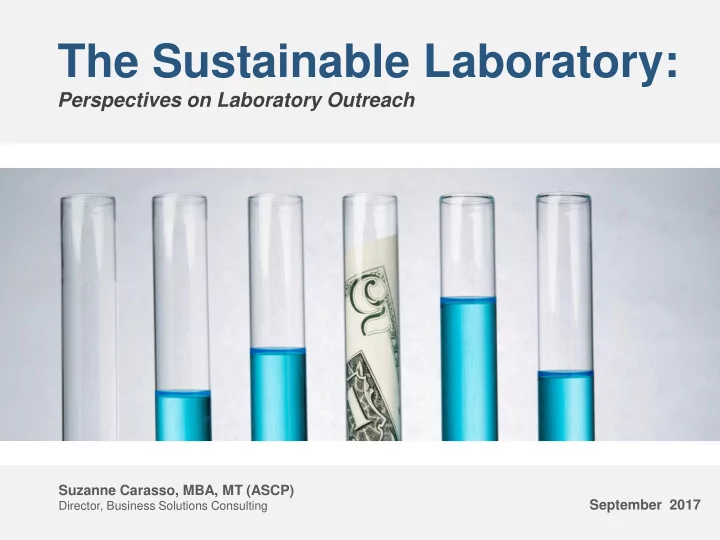

The Sustainable Laboratory: Perspectives on Laboratory Outreach Suzanne Carasso, MBA, MT (ASCP) September 2017 Director, Business Solutions Consulting
Hurricane Harvey 2
Hurricane Irma 3
Price is Value is what you what you pay. get. — Warren Buffet 4
Demonstrating Value in New Ways 5
For the past decade, labs have been challenged with ongoing reductions in reimbursement and budget cuts. As a result, many labs today are operating with very narrow margins. And the light at the end of the tunnel might just be a fast train moving at warp speed toward every lab in operation today… 6
“As fee -for-service disappears, labs will be paid according to how they add value to physicians and help improve patient outcomes.” 7
Outreach: The Historical Perspective Volume-centric Run like a ‘Mom and Pop’ business 8
Outreach: The Perspective Today Revenue-centric With the right management and access to capital, outreach programs today are recognized as one of the most profitable business units in the laboratory industry. Source: Chi Solutions Comprehensive National Outreach Laboratory Survey, 2014; Executive Brief: Fifteenth Annual Outreach Survey Findings, 2016. 9
Outreach: The Perspective Today Revenue-centric In spite of strong outreach profitability, many programs lack essential infrastructure to operate as a competitive business unit. Did you know? 74% do not receive periodic profitability reports. 43% do not have full-time sales representatives. 57% state the average net new sales/month is $2,000 or less. 35% do not have connectivity to client EMRs. 59% are not using or planning to use a CRM system. 56% use the hospital finance department for outreach billing. 10
Outreach: Going Forward Patient-centric “Evidence is accumulating that ‘patient - centric’ medical laboratory testing services are poised to become one of the most important new paradigms to reshape the house of pathology and clinical laboratory medicine in decades. Better yet, patient- centric lab services will earn more revenue for those labs that move fastest to incorporate these capabilities into their service mix.” -Robert Michel, Editor-in-Chief, The Dark Report 11
The best way clinical laboratories benefit their parent organizations is by reducing the cost of the overall patient interaction . 12
Driving Cost Down & Improving Outcomes -a case study Objective: Improve patient outcomes while driving down the cost per episode of care. Methicillin-resistant Staphylococcus aureus (MRSA)
Driving Cost Down & Improving Outcomes -a case study Results: Number of high-risk patients screened: 8,968 Reduction in MRSA infections from 2007 – 2012: 56 14
Driving Cost Down & Improving Outcomes -a case study MRSA costs about $10 billion a year to treat in the U.S., averaging about $60,000 per patient. Savings $2.9 million 15
Increasing Revenue and Profitability Labs that offer patient-centric services in ambulatory and outreach settings increase revenue in two primary ways: Increase net collected revenue Improve managed care reimbursement 16
Net Collected Revenue Improve the accuracy of test orders Some labs are improving net collected revenue by working with patients at time-of- service to collect co- pays, deductibles, and out- of-pocket fees. 17
What One Organization Did… Who: 941-bed non-profit hospital in southern U.S. Objective: Increase accuracy of test orders from outreach clients to improve efficiency and revenue. Requirements: IT resource to interface with LIS and existing software systems to enable and support patient-centric algorithms. Outcomes: A single repository containing all lab test orders, regardless of which system originally captured the order. Less patient wait times in the PSCs. Real-time feeds with the hospital’s EHR. Fewer patient call-backs. 18
Managed Care Reimbursement The Facts : Commercial labs have negotiated steeply discounted, exclusive agreements with private payers that rule out independent labs, but not hospitals. As long as a hospital has a contract for inpatient services, the laboratory can provide outreach laboratory services. 19
Managed Care Reimbursement What You Can Do : Build a relationship between your lab and the hospital’s managed care contracting team. Share a compelling value proposition that describes what your lab offers and make sure the message is delivered to payers at the contracting table. Potential Options: Accept the independent laboratory fee schedule with an agreement to offset the loss in other parts of the contract. Accept the same reimbursement as the national labs without the offset in order to access the pull-through business. Cut prices on routine, high-volume tests while charging higher prices on lower volume esoteric tests. 20
What One Organization Did… Who: Incyte Diagnostics The Problem: Clinicians ordering unnecessary and outdated tests that cost a significant amount of money. Action Taken: 1. Incyte Dx leveraged data housed in the laboratory CRM to identify areas of overutilization; then worked to educate and train providers on efficient and appropriate ordering processes. 2. Then delivered the training and education information to their top payers. Outcome: Payers worked directly with the Incyte internal team to authorize retroactive payments, thereby creating a new process of reimbursement for the company. 21
On Becoming A Patient-centric Laboratory -putting it all together It’s estimated that about two million people die each year as a result of Acute Kidney Injury . This condition costs the U.S. health system $10 billion annually . 22
Objective: Increase the number of AKI cases detected over a 12- month period. Actions: Implemented a system-wide clinical decision support alert for AKI. Results: Diagnosis of AKI increased from 615 (2014) to 930 (2015). 23
Outcomes: This early-warning system for AKI helped physicians intervene in a more timely fashion. Using literature estimates of a two-day drop in length of stay per case for patients treated quickly for AKI, the imputed annual savings alone were $875,000 based on 2,190 avoided hospital days . 24
Sustainability is no longer about doing less harm. It’s about doing more good. -Jochen Zeitz 25
Suzanne Carasso, MBA, MT (ASCP) Director Business Solutions Consulting ARUP Laboratories suzanne.carasso@aruplab.com 801.455.8850 26
Recommend
More recommend